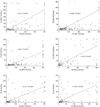|
|
| 1. |
Kavanaugh AF, Solomon DH. American College of Rheumatology Ad Hoc Committee on Immunologic Testing Guidelines. Guidelines for immunologic laboratory testing in the rheumatic diseases: anti-DNA antibody tests. Arthritis Rheum 2002;47:546–555.
|
|
| 2. |
Tan EM, Cohen AS, Fries JF, Masi AT, McShane DJ, Rothfield NF, et al. The 1982 revised criteria for the classification of systemic lupus erythematosus. Arthritis Rheum 1982;25:1271–1277.
|
|
| 3. |
Reveille JD. Predictive value of autoantibodies for activity of systemic lupus erythematosus. Lupus 2004;13:290–297.
|
|
| 4. |
Isenberg D, Smeenk R. Clinical laboratory assays for measuring anti-dsDNA antibodies. Where are we now? Lupus 2002;11:797–800.
|
|
| 5. |
Sinico RA, Bollini B, Sabadini E, Di Toma L, Radice A. The use of laboratory tests in diagnosis and monitoring of systemic lupus erythematosus. J Nephrol 2002;15 Suppl 6:S20–S27.
|
|
| 6. |
Tozzoli R, Bizzaro N, Tonutti E, Villalta D, Bassetti D, Manoni F, et al. Guidelines for the laboratory use of autoantibody tests in the diagnosis and monitoring of autoimmune rheumatic diseases. Am J Clin Pathol 2002;117:316–324.
|
|
| 7. |
Emlen W, Jarusiripipat P, Burdick G. A new ELISA for the detection of double-stranded DNA antibodies. J Immunol Methods 1990;132:91–101.
|
|
| 8. |
Radice A, Sinico RA. A new oligonucleotide-based ELISA for the detection of anti-double-stranded DNA antibodies. Autoimmunity 2006;39:113–119.
|
|
| 9. |
Nossent JC, Huysen V, Smeenk RJ, Swaak AJ. Low avidity antibodies to dsDNA as a diagnostic tool. Ann Rheum Dis 1989;48:748–752.
|
|
| 10. |
Deng JS, Sontheimer RD, Lipscomb MF, Gilliam JN. The binding of antihistone antibodies to Crithidia luciliae kinetoplasts is growth cycle-dependent. Arthritis Rheum 1985;28:163–168.
|
|
| 11. |
Haugbro K, Nossent JC, Winkler T, Figenschau Y, Rekvig OP. Anti-dsDNA antibodies and disease classification in antinuclear antibody positive patients: the role of analytical diversity. Ann Rheum Dis 2004;63:386–394.
|
|
| 12. |
Sinico RA. Interdisciplinary forum on autoimmune disease research: guidelines. G Ital Nefrol 2002;19:212–224.
|
|
| 13. |
Smeenk RJ. Methodological update detection of antibodies to dsDNA: current insights into its relevance. Clin Exp Rheumatol 2002;20:294–300.
|
|
| 14. |
Hylkema MN, Huygen H, Kramers C, vd Wal TJ, de Jong J, van Bruggen MC, et al. Clinical evaluation of a modified ELISA, using photobiotinylated DNA, for the detection of anti-DNA antibodies. J Immunol Methods 1994;170:93–102.
|
|
| 15. |
Rouquette AM, Desgruelles C. Detection of antibodies to dsDNA: an overview of laboratory assays. Lupus 2006;15:403–407.
|
|
| 16. |
Bencivelli W, Vitali C, Isenberg DA, Smolen JS, Snaith ML, Sciuto M, et al. The European Consensus Study Group for Disease Activity in SLE. Disease activity in systemic lupus erythematosus: report of the consensus study group of the European workshop for rheumatology research. III. Development of a computerised clinical chart and its application to the comparison of different indices of disease activity. Clin Exp Rheumatol 1992;10:549–554.
|
|
| 17. |
Kim KH, Han JY, Kim JM, Lee SW, Chung WT. Clinical significance of ELISA positive and immunofluorescence negative anti-dsDNA antibody. Clin Chim Acta 2007;380:182–185.
|
|
| 18. |
Villalta D, Bizzaro N, Corazza D, Tozzoli R, Tonutti E. Evaluation of a new automated enzyme fluoroimmunoassay using recombinant plasmid dsDNA for the detection of anti-dsDNA antibodies in SLE. J Clin Lab Anal 2002;16:227–232.
|
|
| 19. |
Antico A, Platzgummer S, Bassetti D, Bizzaro N, Tozzoli R, Villalta D. Diagnosing systemic lupus erythematosus: new-generation immunoassays for measurement of anti-dsDNA antibodies are an effective alternative to the Farr technique and the Crithidia luciliae immunofluorescence test. Lupus 2010;19:906–912.
|
|
| 20. |
Janyapoon K, Jivakanont P, Surbrsing R, Siriprapapan W, Tachawuttiwat T, Korbsrisate S. Detection of anti-dsDNA by ELISA using different sources of antigens. Pathology 2005;37:63–68.
|
|
| 21. |
Horák P, Ščudla V, Heřmanová Z, Pospíšil Z, Faltýnek L, Budíková M, et al. Clinical utility of selected disease activity markers in patients with systemic lupus erythematosus. Clin Rheumatol 2001;20:337–344.
|
|
| 22. |
Wasmuth JC, Grün B, Terjung B, Homrighausen A, Spengler U. ROC analysis comparison of three assays for the detection of antibodies against double-stranded DNA in serum for the diagnosis of systemic lupus erythematosus. Clin Chem 2004;50:2169–2171.
|
|
| 23. |
Wong KH, Lawton JW, Cheng SK, Lee SS, Lau CS. Measurement of anti-dsDNA: a comparative study of two ELISA and the Crithidia assay. Pathology 1998;30:57–61.
|
|
| 24. |
Tan EM, Smolen JS, McDougal JS, Butcher BT, Conn D, Dawkins R, et al. A critical evaluation of enzyme immunoassays for detection of antinuclear autoantibodies of defined specificities. I. Precision, sensitivity, and specificity. Arthritis Rheum 1999;42:455–464.
|
|
| 25. |
Fritzler MJ, Wiik A, Tan EM, Smolen JS, McDougal JS, Chan EK, et al. A critical evaluation of enzyme immunoassay kits for detection of antinuclear autoantibodies of defined specificities. III. Comparative performance characteristics of academic and manufacturers' laboratories. J Rheumatol 2003;30:2374–2381.
|
|
| 26. |
Blatt NB, Glick GD. Anti-DNA autoantibodies and systemic lupus erythematosus. Pharmacol Ther 1999;83:125–139.
|
|
| 27. |
López-Longo FJ, Rodríguez-Mahou M, Escalona-Monge M, González CM, Monteagudo I, Carreño-Pérez L. Simultaneous identification of various antinuclear antibodies using an automated multiparameter line immunoassay system. Lupus 2003;12:623–629.
|
|
| 28. |
Kim JM, Ihm CH, Sin DH, Ihm MK, Sim SC. Detection of anti-ENA and anti-dsDNA antibodies using line immunoassay in systemic autoimmune diseases. Korean J Lab Med 2008;28:353–361.
|
|
| 29. |
Feltkamp TE, Kirkwood TB, Maini RN, Aarden LA. The first international standard for antibodies to double stranded DNA. Ann Rheum Dis 1988;47:740–746.
|
|




 ePub
ePub Citation
Citation Print
Print









